Still cleaning up after the freeze but making progress
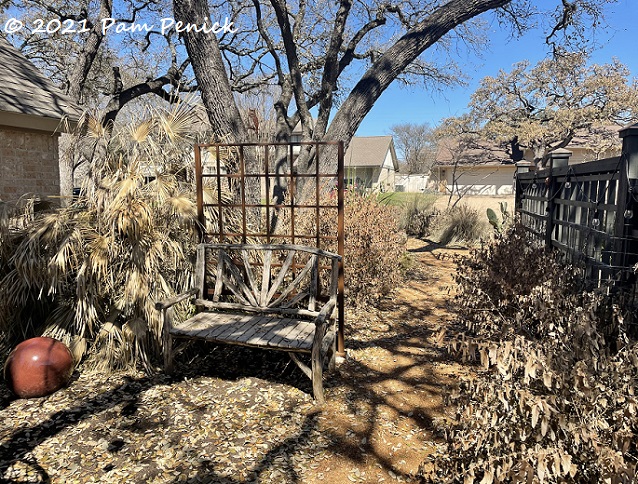
In the 3 weeks since the Big Freeze, there’s been much gnashing of teeth and grim side-eye given to the cold-toasted garden. There’s been escape. But mostly there’s been a slow acceptance of the changed garden and daily efforts at cutting it all back, removing plants that obviously didn’t survive, and closely examining others for signs of life — tiny springs of green poking up at the roots, green “skin” under the bark when scratched with a thumbnail, still-firm centers of partly melted agaves and aloes.
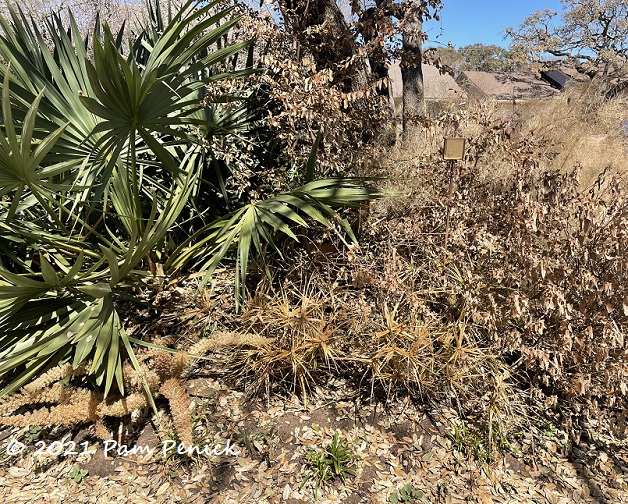
One thing that surprised me is how long it can take some plants to show the impact of an extreme weather event. I’d thought ‘Sparkler’ sedge (center, above) pulled through with minimal damage, since it was still green well after the melt occurred. But by two weeks post-freeze, every ‘Sparkler’ had mostly turned brown, although pale green remains on some lower stems. I’m curious to see if they can come back from the roots. If not I’ll have to pull them.
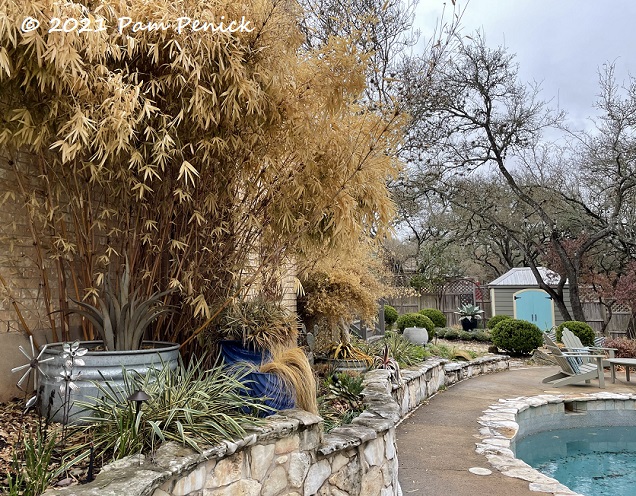
‘Alphonse Karr’ bamboo remains in the iffy category. After a week bowed over with snow and ice, it popped back up looking green and OK. But I knew better, and sure enough, it soon went brown. It’s now shedding golden leaves everywhere and driving my husband nuts as he gets the pool cleaned up, but I don’t want to give up on it just yet. For at least another month, I’ll watch for any signs of life.
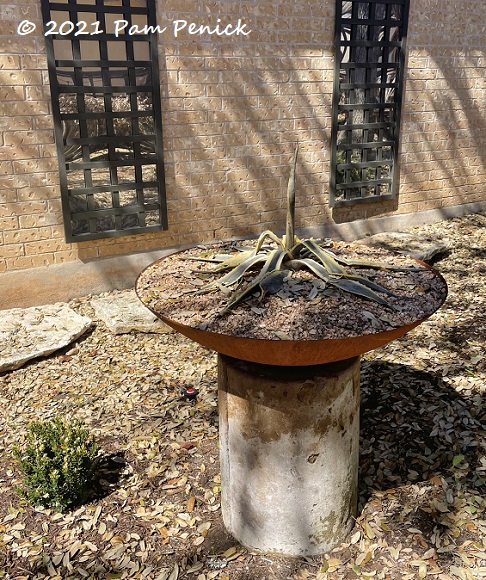
Aside from pruning back woody perennials — always a big job in late winter, compounded by a factor of 10 this year thanks to live oaks that dropped their leaves early in response to the freeze — I’ve been removing mushy, slimy, and kind of disgusting, actually, piles of melted agaves, aloes, and mangaves. This ‘Opal’ variegated American agave never had a chance in an elevated container. I’ve already replaced it.
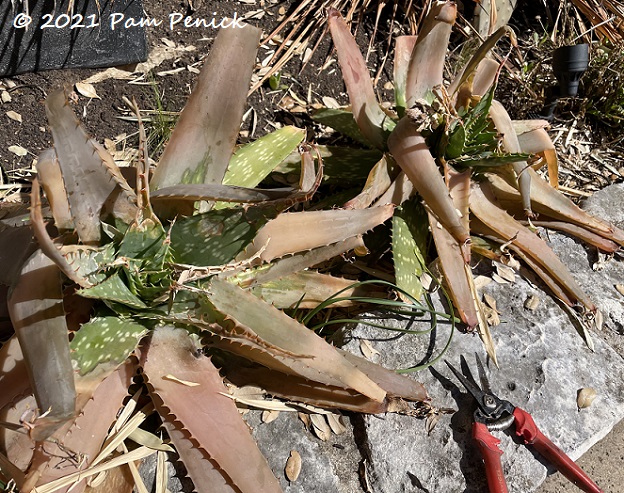
With trepidation I watched a trio of soap aloes (covered with a sheet during the freeze), which have survived at least 10 winters along a south-facing wall, get mushy. But the centers of two of them tenaciously remained green and firm. Amazing!
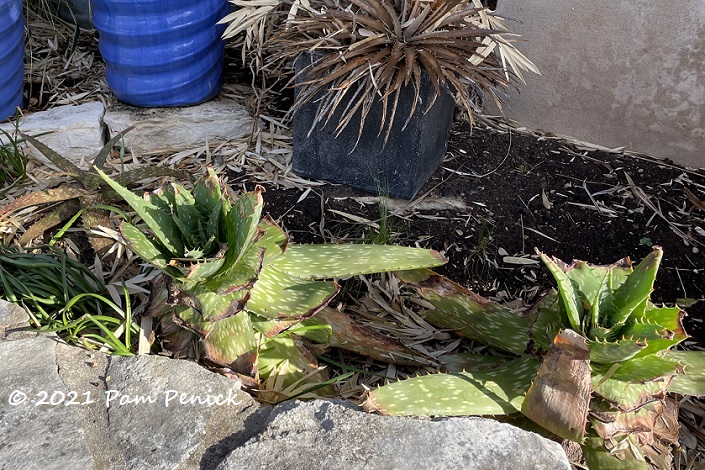
I removed the squishy “arms” and left the centers. They should recover.
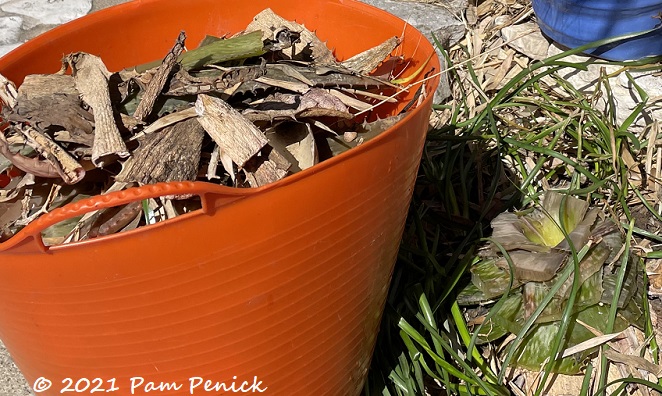
The third one had gone squishy all the way to the center, so I pulled it out and replaced it with a small one from a pot that I’d protected. It’ll grow fast.
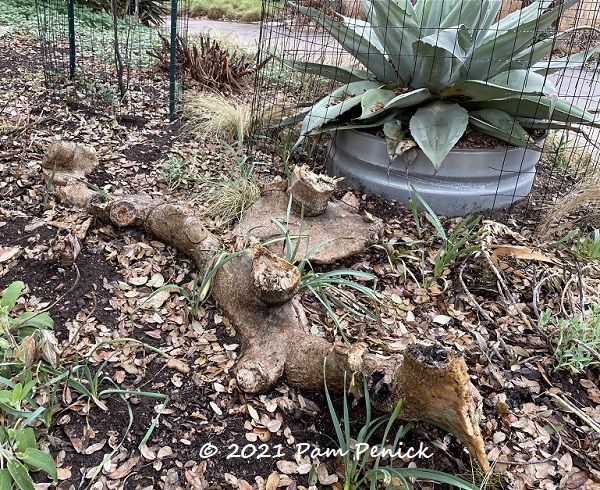
Three cheers for whale’s tongue agave (as if I didn’t adore them already) for largely surviving the Deep Freeze with little damage. I have to remove a big one that bleached out in the back garden, but my other three look great. Not so much, however, the large ‘Old Mexico’ prickly pear, which dominated this bed. It went completely to mush. I cut off all the oozing pads (so heavy!), leaving a dinosaur bone-like “stump.” I’ve seen people walking by doing double-takes at this strange sight. Will it come back from the roots? We’ll have to wait and see.
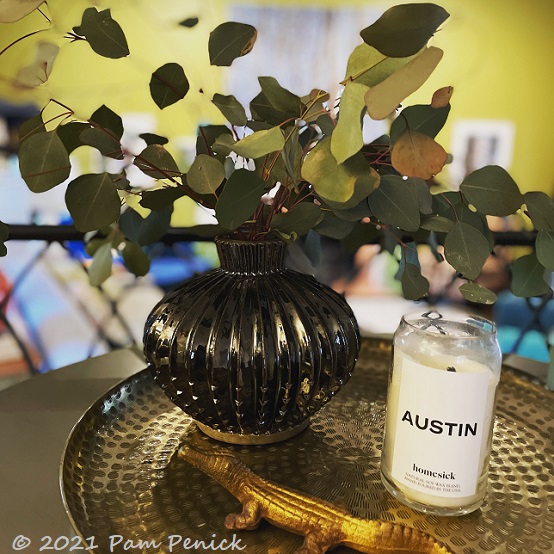
In the midst of all this sorry cleanup, I treated myself to little bouquets of store-bought flowers and eucalyptus leaves that I placed throughout the house.
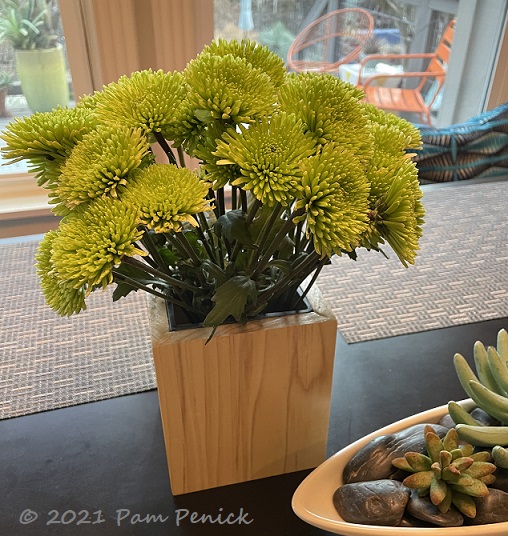
My woodworking sister-in-law made this wooden vase with glass insert for me. Isn’t it pretty?
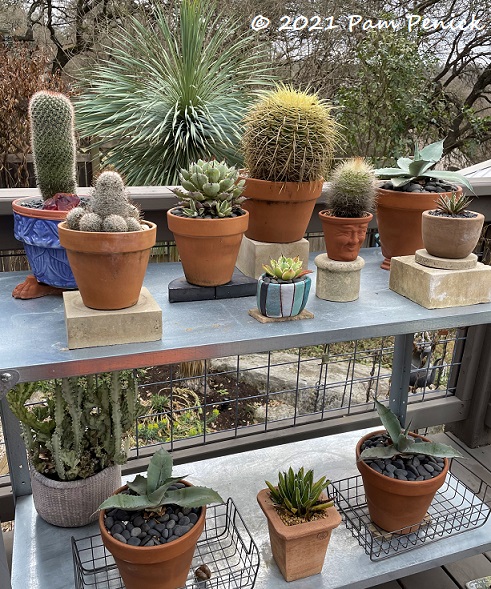
And I busied myself with setting up my cactus/succulent table on the deck. These babies rode out the freeze inside the house, which got pretty cold during 3 days with no heat, but not as cold as outside! Early March is not out of the realm of possibility for a late freeze in central Texas, but I threw caution to the wind and set them up anyway. I needed order and something pretty to look at.
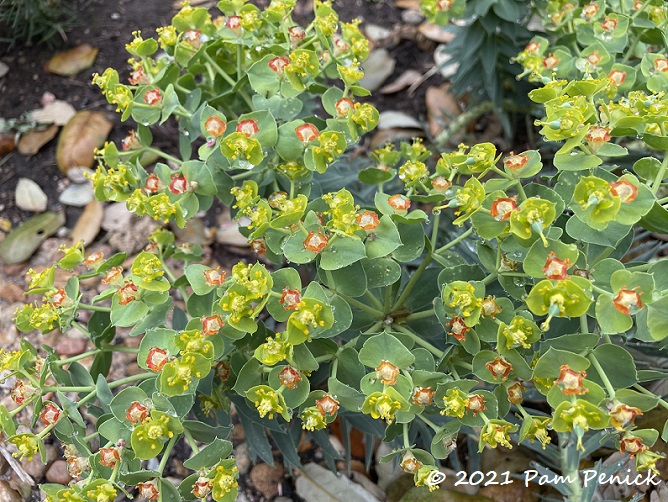
By last weekend, Mother Nature decided to break from the brown, and redbuds, plums, and ornamental pears began blooming all around town. My Japanese maple unfurled tender new leaves. And I’m enjoying the chartreuse flowers of gopher plant (Euphorbia rigida ‘Winter Blush’).
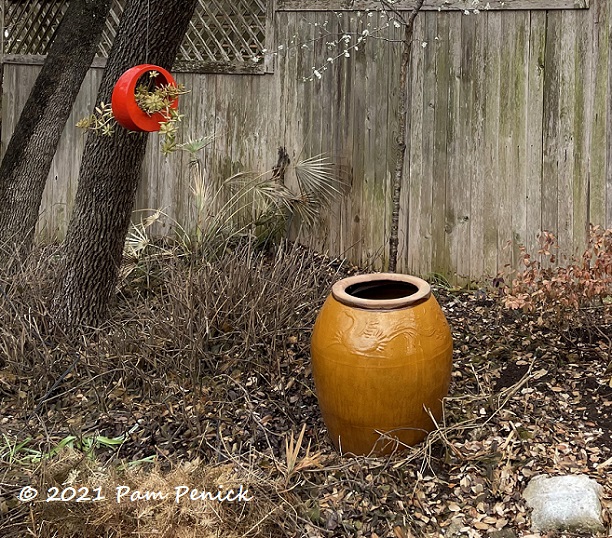
There’s still much brown…
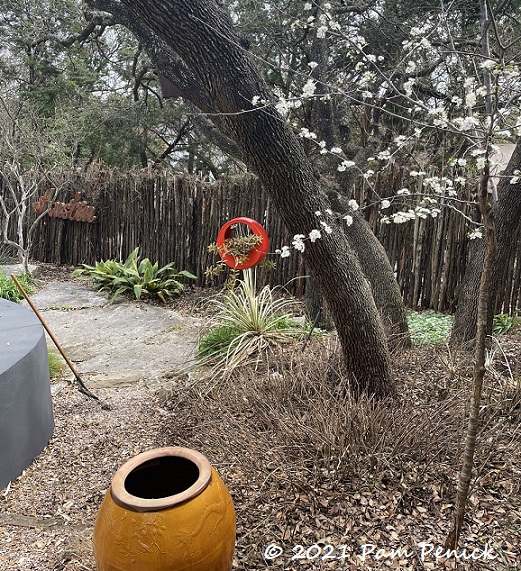
But signs of renewal are here. Mexican plum, spiderwort, gopher plant, redbud are blooming in my garden. It’s not a lot, but it’s a start. And woody perennials like Mexican honeysuckle (the brown stems) are coming back from the roots. It got up to 86 F yesterday and will do so again today, and rain is expected. The heat and rain will make the survivors leap, I think.
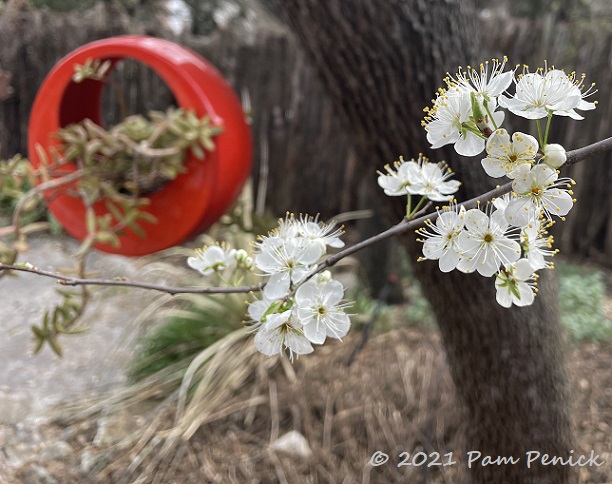
Right now it’s all about the small details. I am grateful for each one.
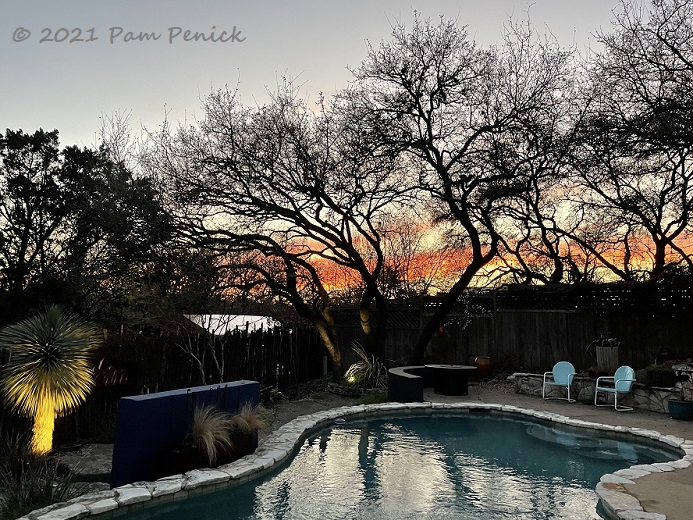
The garden teaches resiliency and faith in spring’s renewal. It’s coming. Hang in there, my fellow Texas gardeners.
__________________________
Digging Deeper
Come learn about gardening and design at Garden Spark! I organize in-person talks by inspiring designers, landscape architects, authors, and gardeners a few times a year in Austin. These are limited-attendance events that sell out quickly, so join the Garden Spark email list to be notified in advance; simply click this link and ask to be added. Season 8 kicks off in fall 2024. Stay tuned for more info!
All material © 2025 by Pam Penick for Digging. Unauthorized reproduction prohibited.


It’s all pretty distressing, but as I cut away the dead sparkler sedge it showed fresh green shoots. I thought it was a goner. So we all need to be patient and see what may return.
Here’s hoping for more happy surprises in both our gardens, Gretchen.
I applaud you for tackling what I’m sure is a trying process, both physically and emotionally. Patience has never been my primary virtue and I can only imagine how I’d handle such a situation as the closest I’ve come was a scorching sustained heatwave and the impact of that isn’t comparable to the damage your garden sustained. However, I’ve learned that plants can surprise you and I hope you’re in for some of those surprises in the future.
Kris, having gardened through both a multi-year epic drought and a week-long killing freeze, I can say definitively that while the shock is greater and more immediate with the freeze, the pain of serious drought is much deeper. It makes you question everything you’re doing and ache not only for your own garden but the natural landscape as well. I really feel for you and other gardeners in SoCal as you wait for rain.
Gardening has many challenges but also great rewards. We just have to keep searching out plants that can thrive no matter what Mother Nature dishes out.
It’s so difficult to be patient, isn’t it? I’m happy to hear about your plants that you know pulled through, especially the soap aloes and the whale’s tongue agave. I, too, have been surprised by what survived. Today, I discovered a heavily mulched Boston fern frond coming up from the ground. (I’d planted this fern-ling on a whim. I didn’t think it would survive a regular winter much less the Devil’s Deep Freeze.) I also think my Mascagnia macroptera is still alive at the root. I’m amazed. Love the last photo in this post.–Wow!
I’m glad to hear about your fern and your butterfly vine. I haven’t seen any signs of greenery on my butterfly vine, but I’ve been hopeful that it may come back from the roots. Oh, the chore of cutting it all back though!
Don’t give up on your foxtails – I cut every one of mine back to the ground and new shoots are coming up from almost every single one – and some are already several inches tall! My bicolor iris are also coming back nicely and most of my variegated dianella are as well (they are much slower though). All of my sedum, Mexican heather and even 2 of my lantana are coming back. Everything got cut back to the ground a few weeks ago and a drink of liquid seaweed. My star jasmine has growth at the base but I still need to cut it back and remove it from the trellis. The Carolina jessamine vine also had to be cut back but has several inches of new growth already. What looks iffy right now are my Japanese yew and palo verde tree – waiting for some new buds with my fingers crossed. My redbud tree is definitely the bright spot in the yard right now!
That’s good news about so many of your plants, Kelly! Some of my foxtail ferns are coming back, and some still look dead. But I’m waiting a bit longer on even those. I’m hopeful that my variegated dianella will come back as well, but it isn’t showing any green yet.
Oh Pam! I think of your garden as green and the brown is shocking. Hoping that the sedges, aloes and Bamboo recover. Yes, the little things really help. xoxogail
It’s pretty shocking, all right. Many plants are coming back from the roots, however, and so in many ways it will be a baby garden again.
I live in San Antonio. Very excited to see new growth in my garden too. Foxtail Ferns, Varigated Flax Lillies, Bicolor Iris, Almond Verbena, Lace Leaved Lavendar, Varigated Gingers, Mexican Mint Marigold, Lady Banksia Rose, Gregg’s Mistflower coming back! All 60 of my day lilies are thriving. Wildflowers are blooming! Still on the pending list: olive trees, Mexican Olive Tree, citrus Trees including a 30 year old tangerine tree that looks so sad as it is totally covered with brown leaves. Plum and pear trees have beautiful white blossoms and lovely green leaves. A fruit salad tree I planted before the freeze and which had blossoms on it before the storm is now covered with beautiful new green leaves. Very blessed to see so much has survived. Also putting fish emulsion on my plants to give them a boost.
That’s great news about your survivors, Mary. Like you, I’m very happy to see any plant showing green at this point!
Shocking first photos, but the flowers in the last photos show life finds a way and Spring cannot be stopped. Can bamboo come back from the roots?
Beautiful work by your SIL on that vase, and the last photo is gorgeous. Best wishes
Yes, I think so — at least, I hope so re: the bamboo. I just took another look this morning. My ‘Tiny Fern’ looks OK at the base, but the ‘Alphonse Karr’ is actually looking worse. But a few culms at the very back might have green on them. I may just get in there and prune out the ones that look faded and dull and see if I can find any green ones in the back.
This has been a trying experience, hasn’t it? Like we needed another. Like you, I’m out daily inspecting each little plant, (OK, more like 2 or 3 times daily!), and the bits of green are encouraging. Hopefully things will look closer to normal for all of us before too long. I’m happy to hear your Mexican honeysuckle is coming back from the roots. Many of my plants haven’t been in the ground long as this is a relatively new yard for me, and I’ve thought that one was toast, but will hold out hope a little longer. Thank you for sharing how things are going.
Yes, it’s been trying, and it’s hard to be patient. But lots of plants are coming back, and that’s good news, even if it may take a couple years (or more) to get back to the fullness of pre-freeze. Here’s hoping your Mex honeysuckle comes back!
DITTO to the demoralizing effect of all that brown, ditto to spirits rising with the cleanup, ditto to the weight (and STENCH!) of all those mushy cacti and agaves, ditto to the delayed reaction of some things to the freeze (oh, my beautiful olive trees!)…BUT, ditto also to signs of hope and life: lantanas, foxtails, variegated flax, scabiosa, bamboo muhly and crazy creeping phlox literally covered with flowers!…Ours is a very “minimalist” landscape right now, but (1) REALLY cleaned up, raked, pruned, etc. and (2) weren’t we talking a few months ago about being a little bored with our gardens? Be careful what we wish for, huh? Anyway, a good opportunity to edit and rework things a bit, or so I keep telling myself!!!…So glad your soap aloes survived, by the way – I lost my entire “river” of them 🙁
I’m heartened to hear that your bamboo muhly is coming back, LCP — from the roots or from the dead-looking stems? I’ve had new growth from dead-looking stems in previous hard freezes, but this time root growth may be the best I can hope for. Anyway, it’s always a good feeling to get the garden cleaned up for spring. This year, that cleanup was MASSIVE.
So far looks like new stuff only, but I am leaving the old stems in place & pretending I WANT a beige element ion the garden: at least it’s something that is vertical when everything else is flattened…oh, and with regard to breadknives/agaves, I commandeered my husband’s battery-operated reciprocating Sawzall, the free face shield they gave me when I got my vaccine, and gloves/sleeves, of course, and took out virtually ALL the poor agave arms in the yard in less than an hour and a half, and that was almost two dozen large (insert copious weeping here) agaves…worked on agaves both mushy and dried, although wet ones sometimes had a fiber or two requiring a scissor snip at the end…excellent way to vent rage: BONUS!
Thanks for both the bamboo muhly update and your hilarious description of agave disarming. You made me laugh out loud, and that’s especially needed these days.
Ah yes, the “beige component.” I’ve been referring to our yard as a “tan landscape.” Tan and beige are neutrals, as are greens; all appear in nature at different times.
I hold my breath a little every time I see someone declaring a plant “fine” after a cold weather event. It can take quite awhile for death to play out. I am so glad to see a few success stories in your garden, fingers crossed that snaking opuntia trunk pushes out some new pads!
How are the area nurseries doing? I imagine they lost a lot of inventory?
My fingers are crossed for that cactus too. The nurseries lost plants, of course, most conspicuously (maybe only because I was looking for a big one) their stock of Texas mountain laurels. Those native trees don’t have a large growing range, and I suspect most growers are in Texas, so it may be a few years until big ones are available again. But otherwise, the nurseries are getting tons of plants and seem decently stocked, although there are still plants I can’t find right now. There’s a lot of competition as everyone in Austin is buying!
Watching the agaves I thought had survived gradually rot through the center has been the most painful. The sap in those leaves is killer-level mean until the leaves are completely dry, too. (And then you still have the sawtooth edges and scary points on most of them.)
Yuccas in general are in much better shape than agaves, but I think we already knew that to be the case before this freeze.
Have you tried using an old bread knife to prune away those agave leaves, Linda? I’d read that tip before and finally tried it, and OMG — it works like magic! Put on long sleeves and gloves, watch your eyes, and you can get at least the smaller ones with a bread knife.
Surprisingly, an old pair of scissors seems to work the best for us on agave leaves. It cuts through the persistent, resistent fiber. It’s slow going, but we don’t compost much any more, choosing to “donate” most plant material to the city (they can compost bigger chunks than we can, even fish heads and such!) and we don’t want to use too many bags. So we fill a couple of old plastic trash cans with agave leaves each week and work our way through the big agave in back (the only large one I still had. The smaller ones in pots were more easily conquered.)
Try an old serrated bread knife, Linda. It’s SO fast and easy to cut through fibrous agave leaves with it.
Of my newly planted front yard, only the Mexican honeysuckle perished; everything else has new growth! I may lose one or two specimens here and there (for example, only one of the three Ligularia has new growth) but I’m feeling more confident that most should return. I’m most worried about my newly planted Mahonias – all look very deadish except the very bottom of one tall specimen that still has some green at the base. And they are not cheap!
That’s great news overall, Caroline. Except for the mahonias of course. Are you talking ‘Soft Caress’? Mine look dead as doornails.
Yes, ‘Soft Caress’ as well as ‘Narihira.’
Thanks, Caroline.
Think what you are learning from this whole experience that you never knew before!
In the words of Mr. Rogers: “Often when you think think you’re at the end of something, you’re at the beginning of something else.”
We are learning with you! Thank you for your updates! Holding out hope for those ‘iffy’ residents in your planting beds!
Thanks for the good wishes, Heather.
Thanks for all of this information! The freeze took a massive hit on my landscaping but my biggest concern is the willow tree I planted last spring. It was doing amazing and growing like crazy. I think think the freeze completely killed the tree. It looks horrible. Is there any chance a willow tree could have survived?
If you know the botanical name, search online for its hardiness zones. If it’s hardy to zone 7 (we’re normally 8b) that’s a good indicator that it’ll survive. It’s early yet. Plants are still recovering, so it may just need more time to start putting out leaves.
Thank you for your response. I just cannot remember the type of willow it was. I am thinking either a weeping or acacia willow. Is there harm in trimming or pruning off the limbs?
Weeping willows grow in colder climates than ours, and it would probably be leafing out again already. So it’s probably an acacia of some kind, which are somewhat tender in our area.
I wouldn’t prune the limbs only. That will result in a butchered shape for the tree, assuming it survives. If there is no regrowth on the branches but there’s greenery coming up at the roots, you could try cutting the whole thing to the ground and letting it regrow a trunk, assuming it’s able to recover enough to do so. Or, even better, wait until mid-April to give it more time — and more heat — to recover and (hopefully) start re-leafing from the branches.
That’s my two cents. If anyone reading this knows more, feel free to add your two cents. 🙂
I went to natural gardener to pick up some Mexican bush sage, gomphrena and anything really… it was so packed I had to wait in line in the car for over 20 minutes! Next time is a (hopefully quieter) Tuesday!
This will be the most infamous kill of landscaping ever. Every shopping center, apartment complex, home etc will be changed for the next 20 years. Developers will rarely go back and redo areas previously landscaped. Especially as it appears that 95% of the very common Agave Americana is no longer in almost every yard. The HEB up by Lakeline Mall had about 100 Whales Tongue agaves. I’m wondering how they faired?
My new thing is Keep Austin Agave’d and hopefully we can share our pups across the city and get the infamous plant back out there.
I lost about 70% of my garden. It’s very depressing. But it can be rebuilt. Thick walls of Asian jasmine are gone. Huge palms etc.
But coming here, reading your words, and knowing that we are all going through this loss somehow helps.
Thanks
“This will be the most infamous kill of landscaping ever.”
You are right, Michael. This will be the winter we gardeners talk about for years to come. I think there will be hesitancy for a while about replacing plants that got killed off, like our iconic American agaves. Some of my friends are wondering if this is the new normal, and if so, if it’s wise to replant things like pittosporum, agaves, loquats, etc. For my own sanity, I’m operating on the assumption (hope?) that this was a once-every-30-years aberration. While I know extreme weather events are more likely with climate change, the next “event” could easily be a record-breaking heat wave or drought rather than another week-long deep freeze. So I’m replacing some of my killed plants with the same thing, esp. where I’ve found plants that withstand the deer and dry shade I contend with. With others I’m still in wait-and-see mode. And still others I’m leaving as blank spaces for the time being. It’s just too much to deal with all at once.
I’m very sorry about the loss of so much of your garden. I agree that knowing we’re all in this together makes it easier to bear. The whole state got walloped. It’ll be a long road back, but I believe it’ll be quicker than 20 years. Austin’s a gardening town, and we like our plants. As long as the nurseries keep getting new plants in, we’ll keep planting. I’m hopeful that in a year at least all the brown stuff will be cut down, and then those blank spaces will be crying out for new plants. You’ll be ready with your agave pups! I love your plan to Keep Austin Agave’d! If you set up a listing for free agave pups, let me know and I’ll share it with my readers.
Still waiting on my own Alphonse Karr to come back here in central Texas. It’s 4/6/21 and there’s still a bit of green on the stalks. I’m going to keep watering and hoping. 1 monterrey oak and one live oak are just putting out a few new leaves this week. I thought they were dead, but they surprised me.
I hope both our bamboos survive. They’re so beautiful.
That’s a good sign, Judy, and watering will help it recover. I’ve actually decided to take mine out for other reasons, but I’ve planted another one elsewhere. I’m glad to hear your trees are coming back. It’s taking a while for some of mine too.
All of our Alphonse Karr and trees survived the Texas Snowmageddon. That’s some tough bamboo!
That’s great news!
I live in Marble Falls and our 4,500 sq. ft. desert scape was demolished in the recent snowstorm and extended severe freezing. We lost all of our Agaves, Draping Rosemary, Coastal Muhly, Bird of Paradise, etc. However, after 6 years of pulling weeds, a decision was made to switch to Buffalo Grass and a few plants. As the rock and dead plants were hauled away I noticed our Mexican wire grass was fine and I saw green in the base of our Bamboo Muhly. Those plants were saved and now as I water the grass and the plants I noticed that the new shoots of Bamboo Muhly resemble a grass similar to Bermuda. I had never really paid attention to the new growth. The new sprouts are at least 12-15 inches tall. The plants appear to be in good health. Are these, in fact, new Bamboo Muhly shoots? Thanks.
Bamboo muhly coming back from the roots does indeed look just like Bermudagrass. Don’t worry, it will fill out and look normal again in a few months, I think. I’m sorry to hear about all your plant losses. As you point out, it IS hard to keep a rock/gravel garden from being weedy in our climate, so the decision to switch to buffalograss strikes me as a smart yet still water-saving move.